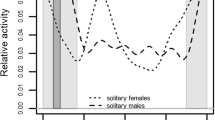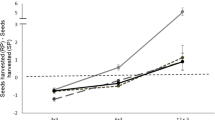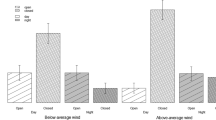Abstract
It is well known that the risk of predation affects prey decision making. However, few studies have been concerned with the cues used by prey to assess this risk. Prey animals may use indirect environmental cues to assess predation hazard since direct evaluation may be dangerous. I studied the assessment of predation risk, manipulated via environmental illumination level, and the trade-off between foraging and predation hazard avoidance in the nocturnal rodent Phyllotis darwini (Rodentia: Cricetidae). In experimental arenas I simulated dark and full moon nights (which in nature correlate with low and high predation risk, respectively) and measured the immediate responses of animals to flyovers of a raptor model. Second, varying illumination only, I evaluated patch use, food consumption, central place foraging, and nocturnal variation of body weight. During flyover experiments, animals showed significantly more evasive reactions under full moon illumination than in moonless conditions. In the patch use experiments, rodents significantly increased their giving-up density and decreased their total food consumption under moonlight. On dark nights, rodents normally fed in the food patch, but when illumination was high they became central place foragers in large proportion. Moreover, the body weight of individuals decreased proportionately more during bright nights. These results strongly suggest that P. darwini uses the level of environmental illumination as a cue to the risk of being preyed upon and may sacrifice part of its energy return to avoid risky situations.
Similar content being viewed by others
References
Abrahams MV, Dill LM (1989) A determination of the energetic equivalence of the risk of predation. Ecology 70:999–1007
Abrams PA (1993) Optimal traits when there are several costs: the interaction of mortality and energy costs in determining foraging behavior. Behav Ecol 4:246–253
Bowers MA (1990) Exploitation of seed aggregates by Merriam's kangaroo rat: harvesting rates and predatory risk. Ecology 71:2334–2344
Brown JS (1988) Patch use as an indicator of habitat preference, predation risk, and competition. Behav Ecol Sociobiol 22:37–47
Brown JS, Kotler BP, Smith RJ, Wirtz WO (1988) The effect of owl predation on the foraging behavior of heteromyid rodents. Oecologia 76:408–415
Brown JS, Morgan RA, Dow BD (1992) Patch use under predation risk: II. a test with fox squirrels, Sciurus niger. Ann Zool Fenn 29:311–318
Clarke JA (1983) Moonlight's influence on predator/prey interactions between short-eared owls (Asio flammeus) and deermice (Peromyscus maniculatus). Behav Ecol Sociobiol 13:205–209
Cortés A, Zuleta C, Rosenmann M (1988) Comparative water economy of sympatric rodents in a Chilean semi-arid habitat. Comp Biochem Physiol 91A:711–714
Covich AP (1976) Analyzing shapes of foraging areas: some ecological and economical theories. Annu Rev Ecol Syst 7:235–257
Daly M, Behrends PR, Wilson MI, Jacobs LF (1992) Behavioural modulation of predation risk: moonlight avoidance and crepuscular compensation in a nocturnal desert rodent, Dipodomys merriami. Anim Behav 44:1–9
Dill LM, Fraser AHG (1984) Risk of predation and the feeding behavior of juvenile coho salmon (Oncorhynchus kisutch). Behav Ecol Sociobiol 16:65–71
Edmunds M (1974) Defence in animals Longman, Essex
Ewert JP (1980) Neuroethology: and introduction to the neurophysiological fundamentals of behavior. Springer, Berlin
Garland T (1983) Scaling the ecological cost of transport to body mass in terrestrial mammals Am Nat 121:571–587
Gilliam JF, Fraser DF (1987) Habitat selection under predation hazard: test of a model with foraging minnows. Ecology 68:1856–1862
Glanz WE (1977) Comparative ecology of small mammal communities in California and Chile. PhD dissertation, University of California, Berkeley
Godin JJ (1990) Diet selection under the risk of predation. In: Hughes RN (ed) Behavioural mechanisms in food selection. Springer, Heildelberg, pp 739–770
Grodzinski W, Wunder BA (1975) Ecological energetics of small mammals In: Golley FB, Petrusewicz K, Ryszkowski L (eds) Small mammals: their productivity and population dynamics Cambridge University Press, Cambridge, pp 173–204
Harris JH (1984) An experimental analysis of desert rodent foraging ecology. Ecology 65:1579–1584
Houston AI, Clarck CW, McNamara JM, Mangel M (1988) Dynamic models in behavioural and evolutionary ecology. Nature 332:29–34
Hughes JJ, Ward D (1993) Predation risk and distance to cover affect foraging behaviour in Namib Desert gerbils. Anim Behav 46:1243–1245
Iriarte JA, Contreras LC, Jaksic FM (1989) A long term study of a small mammal assemblage in the central Chilean matorral. J Mammal 70:79–87
Jaksić FM, Marti CD (1984) Comparative food habits of Bubo owls in mediterranean-type ecosystems. Condor 86:288–296
Jaksić FM, Simonetti JA (1987) Predator/prey relationships among terrestrial vertebrates: an exhaustive review of studies conducted in southern South America. Rev Chil Hist Nat 60:221–244
Kaufman DW, Kaufman GA (1982) Effect of moonlight on activity and microhabitat use by Ord's kangaroo rat (Dipodomys ordii). J Mammal 63:309–312
Kotler BP (1984) Risk of predation and the structure of desert rodent communities. Ecology 65:689–701
Kotler BP (1992) Behavioral resource depression and decaying perceived risk of predation in two species of coexisting gerbils. Behav Ecol Sociobiol 30:239–244
Kotler BP, Brown JS, Smith RJ, Wirtz WO II (1988) The effects of morphology and body size on rates of owl predation on desert rodents. Oikos 53:145–152
Kotler BP, Brown JS, Hasson O (1991) Factors affecting gerbil foraging behavior and rates of owl predation. Ecology 72:2249–2260
Lima SL (1985) Maximizing feeding efficiency and minimizing time exposed to predators: a trade-off in the black-capped chickadee. Oecologia 66:60–67
Lima SL (1986) Predation risk and unpredictable feeding conditions: determinants of body mass in birds. Ecology 67:377–385
Lima SL, Dill LM (1990) Behavioral decisions made under the risk of predation: a review and prospectus. Can J Zool 68:619–640
Lima SL, Valone TJ (1986) Influence of predation risk on diet selection: a simple example in the grey squirrel. Anim Behav 34:536–544
Lima SL, Valone TJ, Caraco T (1985) Foraging-efficiency-predation-risk trade-off in the grey squirrel. Anim Behav 33:155–165
Lockard RB, Owings DH (1974) Moon-related surface activity of bannertail (Dipodomys spectabilis) and fresno (D. nitratoides) kangaroo rats. Anim Behav 22:262–273
Longland WS, Price MV (1991) Direct observations of owls and heteromyid rodents: can predation risk explain microhabitat use? Ecology 72:2261–2273
Mangel M, Clark CW (1988) Dynamic modeling in behavioral ecology. Princeton University Press, Princeton
McNamara JM, Houston AI (1990) The value of fat reserves and the tradeoff between starvation and predation. Acta Biotheor 38:37–61
Meserve PL (1981) Trophic relationships among small mammals in a Chilean semiarid thorn scrub community. J Mammal 62:304–314
Milinski M, Heller R (1978) Influence of a predator on the optimal foraging behaviour of sticklebacks (Gasterosteus aculeatus L.). Nature 275:642–644
Morse DH (1980) Behavioral mechanism in ecology. Harvard University Press, Cambridge
Newman JA, Caraco T (1987) Foraging, predation hazard and patch use in grey squirrels Anim Behav 35:1804–1813
Orians GH, Pearson NE (1979) On the theory of central place foraging. In: Horn DJ, Mitchell RD, Stairs GR (eds) Analysis of ecological systems Ohio State University Press, Columbus, pp 155–177
Phelps MT, Roberts WA (1989) Central-place foraging by Rattus norvegicus on a radial maze. J Comp Psychol 103:326–338
Price MV (1978) Seed dispersion preferences of coexisting desert rodent species. J Mammal 59:624–626
Price MV, Reichman OJ (1987) Distribution of seeds in Sonoran desert soils: implications for heteromyid foraging. Ecology 68:1797–1811
Reichman OJ, Oberstein D (1977) Selection of seed distribution types by Dipodomys merriami and Perognathus amplus. Ecology 58:636–643
Schmidt-Nielsen K (1984) Scaling: why is animal size so important? Cambridge University Press, Cambridge
Schoener TW (1979) Generality of the size-distance relation in models of optimal feeding. Am Nat 114:902–914
Schoener TW (1987) A brief history of optimal foraging theory. In: Kamil AC, Krebs JR, Pulliam HR (eds) Foraging behavior. Plenum, New York, pp 5–67
Sih A (1982) Foraging strategies and the avoidance of predation by an aquatic insect, Notonecta hoffmanii. Ecology 63:768–796
Sih A (1993) Effects of ecological interactions on forager diets: competition, predation risk, parasitism and prey behaviour. In: Hughes RN (ed) Diet selection: an interdisciplinary approach to foraging behaviour. Blackwell Scientific, Oxford, pp 182–211
Simonetti JA (1989) Microhabitat use by small mammals in central Chile. Oikos 56:309–318
Sokal RR, Rohlf FJ (1981) Biometry, 2nd edn. Freeman, San Francisco
Stephens DW, Krebs JR (1986) Foraging theory. Princeton University Press, Princeton
Taylor CR, Schmidt-Nielsen K, Raab JL (1970) Scaling of energetic cost of running to body size in mammals. Am J Physiol 219:1104–1107
Thompson SD (1985) Bipedal hopping and seed-dispersion selection by heteromyid rodents: the role of locomotion energetics. Ecology 66:220–229
Valone TJ, Lima SL (1987) Carrying food items to cover for consumption: the behavior of ten bird species feeding under the risk of predation. Oecologia 71:286–294
Vásquez RA (1992) Exito de forrajeo: comparaciones interfenotipicas en roedores. MSc thesis, Universidad de Chile, Santiago, Chile
Werner EE, Gilliam JF, Hall DJ, Mittelbach GG (1983) An experimental test of the effects of predation risk on habitat use in fish. Ecology 64:1540–1548
Wolfe JL, Summerlin CT (1989) The influence of lunar light on nocturnal activity of the old-field mouse. Anim Behav 37:410–414
Author information
Authors and Affiliations
Rights and permissions
About this article
Cite this article
Vásquez, R.A. Assessment of predation risk via illumination level: facultative central place foraging in the cricetid rodent Phyllotis darwini . Behav Ecol Sociobiol 34, 375–381 (1994). https://doi.org/10.1007/BF00197008
Received:
Accepted:
Issue Date:
DOI: https://doi.org/10.1007/BF00197008




